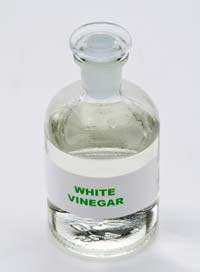
In this activity, you use a raw chicken egg to help students visualize diffusion in microscopic cells.
The egg's shell is made of calcium carbonate, like the shells of marine organisms. Beneath the shell, is a semi-permeable membrane, much like what surrounds the cells of animals. The membrane allows certain substances to pass through. If the shell of a raw egg is removed, the remaining membrane permits the diffusion of substances. The white part of the egg is the cell's cytoplasm. It is called albumin, which consists of 15% protein dissolved in water. The yolk (yellow part) is the nutrients for a developing chick embryo (or us). Check Out my TikTok Video Demonstration Below, and then read on for more details!
Day 1: Place the model cell in vinegar
On the first day of the lab, ask students to make observations about the raw egg. They may note its color, shape, and texture. After doing so, they will add 200 ml of vinegar to a container and place the egg in it. Make predictions about what will happen to the egg sitting in the vinegar overnight. (The acetic acid in the vinegar will wear away the calcium carbonate shell). day 2: Place the model cell in corn syrup
On day two of the lab, students should carefully remove the egg from the vinegar and measure the liquid that is remaining in the container. They will observe that there is less than the 200 ml that they put in. They may also observe that, in addition to the shell being degraded, the egg is larger and they may be able to see the yellow yoke due to the translucence of the membrane. It may be tempting to try to bounce the now soft egg, but we don't want it to break!!!
Since the egg is larger and there is less liquid in the container than they put in, students my infer that water from the vinegar moved into the egg through the process of osmosis. Next, students should put 200 ml of corn syrup in the container and place the egg within it. Ask them to predict what will happen to the egg sitting in the syrup overnight. Day 3: Place the model cell in water
On the third day of the lab, have students carefully remove the egg and measure the liquid remaining in the container. This time, they will observe that there is more than the 200 ml that they put in. They will certainly notice that the egg has deflated considerably--It looks like a beanbag chair!
Since the egg is smaller and there is more liquid in the container than they put in, students might infer that water from the egg moved out through the process of osmosis. Next, students should put 200 ml of water in the container and place the egg within. Ask them to predict what will happen to the egg sitting in the water overnight. Day 4: discuss other examples of passive transport
On day four of the lab, students will notice that the egg is even bigger than when it started after sitting in water over night. Measurement of the liquid in the container should show that there is less than the 200 ml that was placed in the day before.
Since the egg is bigger and there is less liquid in the container, students should now know that water diffused into the egg through the process of osmosis.
At this point, compare student experiences to other examples of diffusion. Ask: Why would a living cell placed in syrup probably lose water? Why are fresh fruits and vegetables sprinkled with water at the market? Roads are sometimes salted to melt ice. What does this salting do to the plants along the road side? Why do the plants sometimes look yellow? Why do dried fruits and dried beans swell when they are cooked?
The concepts of both passive and active transport are instrumental to understanding the functional role of the cell membrane in cell survival. Diffusion of substances and osmosis of water molecules are processes that help cells maintain homeostasis--a major concept in biology. This egg diffusion hands-on lab is a fun way for students to see these processes in action. If you're interested in keeping a collection of labs to use in the classroom, check out my 40 Biology Lab Activities book - available in eBook format as well as in print!
0 Comments
Leave a Reply. |
AuthorGertrude Katz has spent over 30 years teaching K-12 public school students all major subjects. She has taught biology and education at the college level. The majority of her career has been spent instructing biology at the secondary level. Categories
All
|

 RSS Feed
RSS Feed